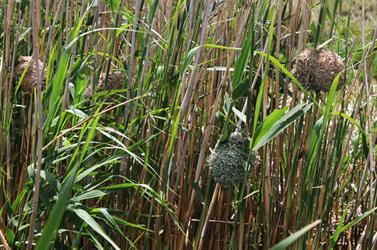The White-winged Flufftail, a highly endangered bird species, was spotted less than 70 km from the UFS Qwaqwa Campus, home of the Afromontane Research Unit (ARU). In collaboration with BirdLife South Africa, the ARU is conducting a study to find out if this species also made its home in the Golden Gate Highlands National Park.
This rare species has so far only been found at three sites in South Africa.
Study to benefit local community
One of the ARU’s goals is to undertake research that will benefit the local communities, including SANParks. Should it be confirmed that these rare birds are also found in the area, the status of the Golden Gate Highlands National Park in the Important Birding Area (IBA) directory is likely to increase.
Prof Aliza le Roux, Associate Professor in the Department of Zoology and Entomology on the Qwaqwa Campus of the University of the Free State (UFS) and affiliated to the ARU, is conducting the study. She is also involved in other wetland studies.
According to Prof Le Roux, it is very difficult to find the bird. In a study, Prof Le Roux, Dr Sandy-Lynn Steenhuisen (botanist in the Department of Plant Sciences), and Dr Ralph Clark (ARU Director) have been deploying song meters in a rolling grid in the wetland areas, recording all bird noises around dawn and dusk. This is a non-invasive method to record bird sounds and helps to maintain the health of wetlands.
With these song meters they are trying to create a soundscape of the wetlands, recording all the sounds of the area by changing the location of the song meters every two weeks to cover the entire 2 km-long wetland area. Soundscape ecology is a fairly new technique and could be an effective way of measuring wetland health in high-altitude settings.
“In contrast with camera traps, song meters do not need a direct line of sight to record the presence of a specific bird – it can pick up songs from 150 m away in all directions. Camera traps may, however, be useful for adding visual confirmation of any bird’s presence, which is useful for a species that has only been heard a few times. In fact, no recording of the White-winged Flufftail’s call is currently in the public domain,” says Dr Le Roux.
Collaboration with Japanese university
Using these recordings from the soundscape, the team identifies the different bird, frog, and insect sounds recorded. According to Prof Le Roux, they are fairly new to the process and she would like to learn more, specifically about the analysis of the song diversity. She is visiting researchers at the Okinawa Institute of Science and Technology (OIST) in Japan in early December to investigate the variety of tools available to effectively analyse terabytes of acoustic data. Researchers at OIST have done similar studies on soundscapes in Okinawa along an urban gradient, and their expertise as well as access to a supercomputer could boost this research significantly.
The Qwaqwa area is on the border of the White-winged Flufftail’s expected distribution range.
“Because they and their habitat are threatened,
we are not sure if they are in the area;
and whether they may only be here to breed.”
—Prof Aliza Le Roux,
Associate Professor, UFS.
“If we find that they did make the park their home, they will be more protected, as the park is a conservation area.”

Prof Aliza le Roux and Dr Mpho Ramoejane (camera-trap expert) at a wetland area in the Golden Gate National Park. The wetlands often get trampled, affecting the condition of the area. Interestingly, trampling improves conditions for flufftails, as the cattle open up spaces between the reeds.
Photo: Leonie Bolleurs